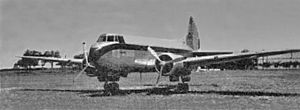Type a search term to find related articles by LIMS subject matter experts gathered from the most trusted and dynamic collaboration tools in the laboratory informatics industry.
| C-202 Halcón | |
|---|---|

| |
| Role | transport |
| National origin | Spain |
| Manufacturer | CASA |
| First flight | May 15, 1952 |
| Primary user | Spanish Air Force |
| Number built | 20 |
The CASA C-202 Halcón was a twin-engine transport aircraft, constructed by CASA.
The Halcón was designed for use on Spain's international air routes. It had tricycle landing gear and a heated/air-conditioned cabin which could accommodate fourteen passengers. Twenty aircraft were initially ordered, and delivered to the Spanish Air Force with the designation T.6.
Data from Jane's All The World's Aircraft 1961–62[1]
General characteristics
Performance
Related development
{{cite encyclopedia}}: Missing or empty |title= (help)